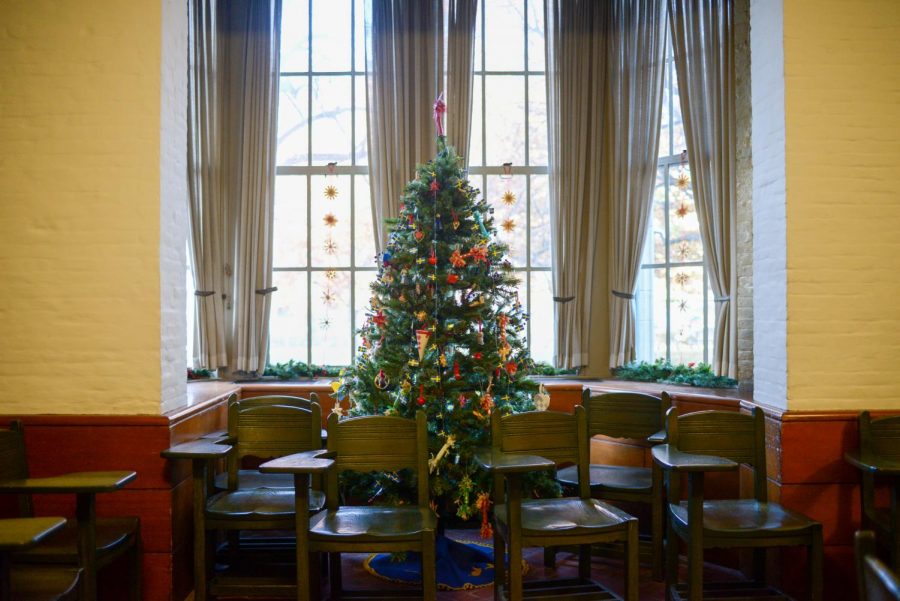Nationality Room Holiday Open House virtually sends viewers around the world
Sarah Cutshall | Visual Editor
The Swedish Nationality room, decorated for the holiday open house in December 2018.
January 19, 2021
Viewers of this year’s virtual Nationality Room Open House could explore the beautiful landscape of Iran and hear Scottish folk songs, all from the comfort of their own homes. In fact, viewers of the videos could experience different cultures and traditions from all 31 Nationality Rooms.
As the pandemic led to limited access in University buildings this past semester, the annual Nationality Room Holiday Open House took on a two-week virtual format this December. The 2020 Nationality Room Holiday Open House, held from Dec. 6 through Dec. 18, consisted of various virtual programs, such as videos of storytelling and musical performances, organized by members of each room’s committee and available through the Pitt Global Hub website.
The Nationality Rooms represent the cultures of various ethnic groups that settled in Pittsburgh, which are supported by the committees of each room. During previous holiday seasons, people could tour the Nationality Rooms, typically decorated for the winter holidays with traditional decor from the country or region of the room. Additionally, various committee members of the Nationality Rooms have previously held a holiday performance celebration on a Sunday afternoon in the Cathedral of Learning Commons Room, an event which has been taking place for the past 30 years.
According to Belkys Torres, executive director of global engagement, the pandemic-prompted virtual model of the open house allowed for creativity and innovation.
“We pivoted to a virtual model and it actually allowed us to be creative and innovative with the format of the virtual open house and, for the very first time, make it a two-week series rather than a day event in person,” Torres said.
Torres said the virtual model allowed for increased engagement compared to previous years, as individuals could interact with the programming at their own pace.
“Overall, everybody who clicked or participated or saw a video or created one had a lot more opportunity for engagement simply because it was virtual,” Torres said. “They did not have to physically be in a space to enjoy performances, storytelling, ornaments or learn about traditions. It was something that they could do at their own pace on their own time.”
In a video from the Welsh Room, Ruthanne Ankney — a member of the St. David’s Society, the organization that created the room — describes the tradition of the Mari Lwyd. This tradition involves groups of people decorating a horse skull, then carrying it door to door. Ankney, a professional storyteller, musician and performer, said the excitement of participating in this event has helped keep this deep-rooted tradition alive.
“It’s become competitive in a very fun, creative way,” Ankney said. “People can find their horse skull. They are so excited for how they will decorate them. It’s great, because that sense of decorating to make it different from another group helps keep the tradition alive.”
Starting out as a theater performer, Ankney eventually discovered her passion for sharing folklore. Being Welsh herself, Ankney said she realizes the importance of folklore to her Welsh heritage.
“I started out as a theater performer,” Ankney said. “But somehow, I made the discovery for my passion for folklore, just the simple format of telling stories and the importance of passing them down to our community. I must have hundreds and hundreds of folktales memorized — it’s just a passion to share them.”
In a video from the Scottish Room, Susan Borowski sang Scottish folk songs and played the guitar and fiddle. Borowski, who recently served as secretary for the room, said she found her way to the room through her love for Scottish music.
“I was in a couple of Celtic bands in Pittsburgh and it was my mandolin teacher who taught me my first Scottish jig,” Borowski, executive assistant to the chair of Pitt’s department of health policy and management, said. “I started playing that music and I fell in love with the country. It all kind of led me to the Scottish Nationality Room.”
While Borowski contributed to the programming of the Scottish Room through her performances, she also enjoyed the programming of other Nationality Rooms. Borowski said she loved the virtual tour of Iran, which showed the beauty of the landscapes of that country.
“The one I loved was the [ video ] from Iran,” Borowski said. “They took you into the landscapes and how beautiful it was there. I was totally impressed.”
Torres said leaders from all of the nationality rooms came together to put together the showcase.
“The interesting thing about this series in particular is that it was, as it always is, a team effort,” Torres said. “Members of the community who are leaders in each of the nationality room committees put together videos that either focused on cultural performances, traditions, ornaments, practices of a particular country or region.”
Borowski said she is proud of the contributions of the various Nationality Rooms and of how the Virtual Holiday Open House compiled these videos to show the beauty of each room.
“I am just so proud of the Nationality Rooms,” Borowski said. “They really just — that whole program really — brought it all together and showed how beautiful each [room] is.”
Like Borowski, Ankney enjoyed watching the videos from the different groups, but she also loved being able to participate and share her own culture with viewers.
“I sat and watched just about all of the virtual programs. I love folklore. I admired the staff for being able to put together such a luscious and visually interesting program so fast,” Ankney said. “I was thrilled to be a part of it.”








